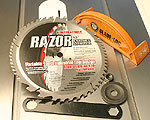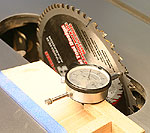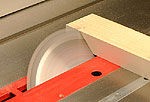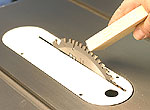 |
Don't let the fancy graphics fool you, this is a workhorse blade that cuts very well.
Click image to enlarge |
Porter Cable Razor Blade
A radical - but effective - departure in tooth design
Text and Photos by Tom Hintz
New thinking in woodworking blade designs can be a little hard to accept. In the case of the Porter Cable Razor series, the visual impact of their variable tooth arrangement might leave you a bit skeptical, as it did us. The skepticism ended when we cut wood with it. The Porter Cable Razor may look like some kind of manufacturing error but the quality of the cut it produces is strictly by design.
Initial Impressions
The general appearance of the Porter Cable Razor suggests it is well made. Crisp laser cutting of the blade body, clean machining overall and a snug 5/8" bore all contribute to a smooth running blade rated at a maximum of 7000 RPM. The C3 Micrograin carbide teeth are thick, accurately placed on the body and secured with gap-free brazing.
 |
 |
(Top) The tooth layout may look like a huge manufacturing error but turns out to be an effective idea.
(Bottom) Brazing and grinding of the teeth are first rate.
Click image to enlarge |
A close look at the teeth themselves shows fine, consistently ground facets with very clean edges. The sides of the teeth are also precision ground, a feature that no doubt contributes to the smoothness of the cuts the Razor produces.
Variable Tooth Layout
Easily the most eye-catching feature of the Porter Cable Razor is the combination of dramatically different tooth designs laid out around one blade. Actually, the basic idea is simple, combine the qualities of fast cutting and finish tooth designs to produce a blade that does both well. I suspect executing that idea was far more difficult than conceiving it.
The teeth are laid out in two groups, each covering half of the blades circumference. This goes a long way towards keeping the blade in balance but also influences how it cuts.
Another oddity of the Razor is the asymmetrical tooth spacing that Porter Cable claims disrupts harmonics, creating a quieter running blade.
To improve safety, anti-kickback features were designed into the blade and raker teeth used to help prevent the buildup of blade-binding dust in the kerf.
Installation and Baseline Checks
 |
|
(Top) Checking the basic saw alignments whenever a new blade is installed is a good habit that insures getting the most from the investment.
(Bottom) Don't forget to check for clearance between the blade and zero clearance inserts. A small difference in fit could launch the plate on start up!
Click image to enlarge |
Before installing the Porter Cable Razor, the arbor and both flange washers were cleaned to be sure there was no dust or buildup that could cause the blade to run out of line. This should be the standard procedure in all of our shops when installing a new blade.
After installing the Porter Cable Razor, a dial indicator was used to check for runout. The maximum deviation noted was just under 0.002", good by any measure. Parallelism with the miter slot was also checked and indicated almost dead on at 0.001". It is important to note that these are almost identical to the readings taken with the previous blade, suggesting that the majority of what little deviation measured is at least partially the fault of the saw itself and not the blade.
The result of these checks is that the Porter Cable Razor is very straight and that my saw is aligned well. Good alignment is mandatory to get the most from any blade, and in this instance, to be sure the testing generates legitimate results.
My zero clearance throat plate was installed and the Porter Cable Razor rotated with a stick to be sure there was no contact. Even after this test, when starting the saw for the first time I stood to the side just in case. The Porter Cable Razor turned up to speed with no problems.
The last check was to be sure the miter guide was square to the miter slot.
In The Shop
 |
The Razor is quieter than other blades I have used but most important is how it cuts - something it does well.
Click image to enlarge |
One of the first things we noticed about the Porter Cable Razor is that the claim of quieter running appears to be true. The hiss of the teeth whipping through the air is subdued as is the sound generated while cutting wood. Blade noise itself is not a big issue but could be related to how well it is cutting.
Saw blade tests in my shop involve cutting every type of wood I can find, often reducing that stock to saw dust and little pieces. The types of cuts are varied as are the species used.
One of the first tests is to make repeated, long rip cuts trying to build heat in the blade. The Porter Cable Razor seems to resist heat buildup very well and showed no degradation of the cut quality during the transition from cool to the upper limits of its operating temperature. This test was repeated after all other cuts were made without a noticeable increase in maximum blade temperature.
Simple cross cuts in coarse red oak and fast-grown pine left very smooth surfaces. Rip cuts were very straight with glue-ready surfaces. The same cut quality was obtained making angle and bevel cuts in hard and soft woods.
 |
Cuts at 45-degrees were as clean and smooth as simple crosscuts.
Click image to enlarge |
Veneer plywood cut cleanly, approaching the chip-free quality expected from expensive, dedicated plywood blades. Even ¼"-thick ply was cut with virtually no chipping or evidence that the material wanted to lift during cutting.
Pure cut speed is good though not exceptional. The Porter Cable Razor cuts at least as fast as other premium blades I have tested and leaves a smooth surface that rivals the best of them.
The Porter Cable Razor is by no means slow; it's just not super fast either. The combination of speed and cut quality we experienced is on par with other blades costing much more.
The Porter Cable Razor also seems to eject less sawdust above the table than noticed with other blades used on the same Jet Contractor saw equipped with the same zero-clearance throat plate and dust collection system used with other blades.
Conclusions
The Porter Cable Razor 50-tooth Finisher is a solid performer that can handle the varied cut demands of the average woodworking shop. Consistency and smooth cuts in rip, cross cut, angle and bevel modes make this a very versatile blade.
The quality materials and manufacturing of the blade body along with substantial C3 carbide tips mean the Porter Cable Razor will last a long time and can be sharpened, probably more than once if not damaged, making it even more cost effective.
With a street price of $39 (10-22-2004), the Porter Cable Razor represents a good value for the home woodworker who needs solid performance from a blade that handles a wide range of cutting needs.
Do you have a comment about this page? - Email Me!
Back to the Tool Reviews List
|
![]()







